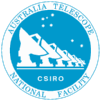Miriad considerations for polarization:
Input from Naomi McClure-Griffiths & Bryan Gaensler on required polarization functionality
We assume that the issues associated with calibrating polarization data over large bandwidths are handled so we start from the imaging.
invert
For polarization imaging where depolarization is a concern the common technique is to image the data in a psuedo spectral manner, i.e. by channel. As you know, for spectral line work invert makes the assumption that \Delta \nu/\nu is small and creates one beam for the entire band. This is fine for narrowband spectral line work, but not good for spectropolarimetry where the bandwidth is large. If one is trying to image 32 spectral channels of 4 MHz, a single beam for the full 128 MHz (or 2 GHz in the future) is not adequate. As a work- around Bryan currently images each of the continuum channels separately so that he gets a beam for each. Obviously this is tedious for tens of channels and simply impossible for 1000 channels. Basically we need the beam to scale with frequency.
In addition, invert and a number of other miriad tasks assume that channel data are spectral line data and referenced to a line velocity. The doppler correction used also makes the assumption of small bandwidth. We need to be able to work with spectral data without assuming that it is doppler shifted data.
deconvolution
pmosmem assumes that Q2 + U2 < I, which is not always true for diffuse polarization. We are also concerned about spectral index aberration effects. mfclean has been designed to handle these effects, but we also need a mfmosmem, mfmaxen, mfpmosmem to cope with the other types of deconvolution needed for diffuse emission. These are further compounded in diffuse polarization work where faraday rotation causes extra frequency dependent effects.
restor
This has the same problems as with invert, the restoring beam needs to be able to scale with frequency.
Polarization tasks
The specific polarization tasks, impol and imrm are rather basic.
- impol
This task has bugs and is fairly simple-minded. It does only one type of debiasing and applies that simply. For example if you want to debias every frequency channel of an image you have to do it separately.
- imrm
This task uses a very simple algorithm to deal with angle wraps that can lead to very wrong and misleading results. There have been more intelligent methods developed, both in the Fourier domain and not. For example, Jo-Anne Brown has published some details on an unwrapping algorithm. As you mentioned, Neil (Killeen) worked on a Fourier method that was implemented in aips++. This method has good uses for Fourier synthesis of diffuse emission, but it's a rather computationally expensive technique to apply for simple RMs of point sources. If we are going to offer a task like imrm that purports to return RMs we need to make sure that it does the best job possible, which it currently does not.
source finding
Source finding tasks imsad and sfind struggle with polarization data. At present one has to run them twice on Q and U data, once for positive sources and once for negative sources. If one is trying to find sources in polarized intensity the problem is even worse because the source finding algorithms assume Gaussian rather than Ricean statistics.
Other issues
- Do we need to worry about frequency dependent off-axis leakages? (VJM 2007-07-10 on-axis leakages are freq-dependent. The question is whether the pattern of the off-axis leakages changes with frequency.)
- It is important to make sure that any changes to images (for example image size scaling with frequency) or beams can still be viewed by (image-viewing tools like) karma.
- Flagging!!
